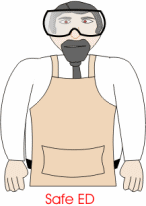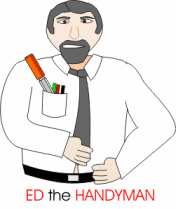|
||||||||||||||||||||||||||||
| Read the safety rules carefully. If you fully understand them you should be able to work safely in a workshop. Do not be like Ed the Handyman !!!! | ||||||||||||||||||||||||||||
|
|
||||||||||||||||||||||||||||
| Why do you think workshop Safety Rules are important? If everyone follows workshop rules, everyone will be safe and learn how to use tools and equipment properly and efficiently. |
||||||||||||||||||||||||||||
| 1. Always listen carefully to the teacher and follow instructions. The instructions given by your teacher, his / her demonstrations on the use of equipment and tools, will help you understand how to work in a workshop safely and efficiently. 2. Do not run / rush in the workshop. You could ‘bump’ into another pupil and cause an accident. You could run into a machine or bench, which could cause a serious injury. 3. Know where the emergency stop buttons are positioned in the workshop. If you see an accident at the other side of the workshop, you can use the emergency stop button to turn off all electrical power to the machines. 4. Always wear an apron. It will protect your clothes and hold loose clothing such as ties in place. This will prevent loose clothing getting caught in a machine, pulling the machine operator into the moving parts. 5. Wear good strong shoes. Training shoes are not suitable. Tools and equipment can have sharp edges and are usually heavy. Good shoes prevent damage to feet, if a piece of equipment or a tool, is dropped on feet. 6. When attempting practical work, all stools should be put away. If stools are left out in the workshop during a practical session, they will get in the way and inevitably become a trip danger. 7. Bags should be stored away, during practical sessions in the workshop. A person can easily trip over a bag left on the floor and accidentally push into someone using a machine. This could cause a serious accident. 8. When learning how to use a machine, listen very carefully to all the instructions given by the teacher. Ask questions, especially if you do not fully understand. It is very important to ask questions, especially when learning how to use machines and tools, if there is a need to clarify instructions. Using a machine without a full understanding of its use, could easily lead to an accident. 9. Do not use a machine, if you have not been shown how to operate it safely, by your teacher. It is extremely dangerous (and illegal), to use a machine in the workshop, without having followed and understood, all the teacher instructions. 10. Always be patient, never rush practical work. The most productive and efficient ‘craftspeople / engineers’, work patiently and never rush their work. Working at a safe, steady pace, is how skilled professions complete their tasks. 11. Always use guards, when operating machines. The guard on a machine, protects the user, especially the users eyes, from dangerous ‘debris’ that is thrown out, often at high speed. The guards also ensure that hands and fingers, are not near moving parts. A good example of a machine guard, is seen in front of the chuck, of a machine drill. 12. Keep hands / hair and clothing away from moving/rotating parts of machinery. Loose Clothing (e.g. a school tie) and long hair, can be caught in the moving parts of a machine (e.g. the chuck of a drill). Hands / clothing should must be kept away, from the moving / rotating parts. Long hair should be tied back. 13. Use hand tools carefully, keeping both hands behind the cutting edge. Never place a hand in front of a cutting tool (e.g. a chisel). There is always a possibility, of the tool slipping and the sharp edge slicing into the hand / fingers. 14. Report any damage / faults to machines/equipment. Damage or a faulty part, could cause an accident. A broken or damaged tool can be dangerous. For example, a hammer with a loose hammer head ,should be reported to the teacher. It is always possible that the hammer head will ‘fly off’ the handle, when it is in use. 15. Keep your workbench tidy. When you have finished with a tool / piece of equipment, return it to its storage cupboard / rack. A bench top, crowded with tools, will eventually lead to one or more, being knocked on to the floor, or on to feet. Tools are damaged easily and people can be injured. 16. Never distract another pupil, when they are working on a machine or using tools / equipment. A distracted pupil could have an accident, as a distraction will take their focus and concentration away from the work they are doing. If using a tool / machine, a distraction can easily lead to an accident. |
||||||||||||||||||||||||||||
|
|
||||||||||||||||||||||||||||

